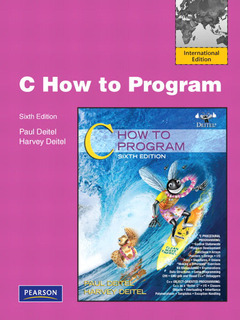C how to program with CD-ROM (6th Ed.)
Auteur : DEITEL Paul

C How to Program, 6e, is ideal for introductory courses in C Programming. Also for courses in Programming for Engineers, Programming for Business, and Programming for Technology. This text provides a valuable reference for programmers and anyone interested in learning the C programming language.
The Deitels' groundbreaking How to Program series offers unparalleled breadth and depth of object-oriented programming concepts and intermediate-level topics for further study.
Using the Deitels' signature 'Live-Code Approach,' this complete, authoritative introduction to C programming offers strong treatment of structured algorithm and program development in ANSI/ISO C with 150 working C programs. Includes rich, 300-page treatment of object-oriented programming in C++ that helps readers interpret the code more effectively.
1 Introduction to Computers, the Internet and the Web
1.1 Introduction
1.2 Computers: Hardware and Software
1.3 Computer Organization
1.4 Personal, Distributed and Client/Server Computing
1.5 The Internet and the World Wide Web
1.6 Machine Languages, Assembly Languages and High-Level Languages
1.7 History of C
1.8 C Standard Library
1.9 C++
1.10 Java
1.11 Fortran, COBOL, Pascal and Ada
1.12 BASIC, Visual Basic, Visual C++, C# and .NET
1.13 Key Software Trend: Object Technology
1.14 Typical C Program Development Environment
1.15 Hardware Trends
1.16 Notes About C and This Book
1.17 Web Resources
2 Introduction to C Programming
2.1 Introduction
2.2 A Simple C Program: Printing a Line of Text
2.3 Another Simple C Program: Adding Two Integers
2.4 Memory Concepts
2.5 Arithmetic in C
2.6 Decision Making: Equality and Relational Operators
3 Structured Program Development in C
3.1 Introduction
3.2 Algorithms
3.3 Pseudocode
3.4 Control Structures
3.5 The if Selection Statement
3.6 The ifelse Selection Statement
3.7 The while Repetition Statement
3.8 Formulating Algorithms Case Study 1: Counter-Controlled Repetition
3.9 Formulating Algorithms with Top-Down, Stepwise Refinement Case Study 2: Sentinel-Controlled Repetition
3.10 Formulating Algorithms with Top-Down, Stepwise Refinement Case Study 3: Nested Control Structures
3.11 Assignment Operators
3.12 Increment and Decrement Operators
4 C Program Control
4.1 Introduction
4.2 Repetition Essentials
4.3 Counter-Controlled Repetition
4.4 for Repetition Statement
4.5 for Statement: Notes and Observations
4.6 Examples Using the for Statement
4.7 switch Multiple-Selection Statement
4.8 dowhile Repetition Statement
4.9 break and continue Statements
4.10 Logical Operators
4.11 Confusing Equality (==) and Assignment (=) Operators
4.12 Structured Programming Summary
5 C Functions
5.1 Introduction
5.2 Program Modules in C
5.3 Math Library Functions
5.4 Functions
5.5 Function Definitions
5.6 Function Prototypes
5.7 Function Call Stack and Activation Records
5.8 Headers
5.9 Calling Functions By Value and By Reference
5.10 Random Number Generation
5.11 Example: A Game of Chance
5.12 Storage Classes
5.13 Scope Rules
5.14 Recursion
5.15 Example Using Recursion: Fibonacci Series
5.16 Recursion vs. Iteration
6 C Arrays
6.1 Introduction
6.2 Arrays
6.3 Defining Arrays
6.4 Array Examples
6.5 Passing Arrays to Functions
6.6 Sorting Arrays
6.7 Case Study: Computing Mean, Median and Mode Using Arrays
6.8 Searching Arrays
6.9 Multiple-Subscripted Arrays
Date de parution : 11-2009
Ouvrage de 998 p.
17.8x23.2 cm



